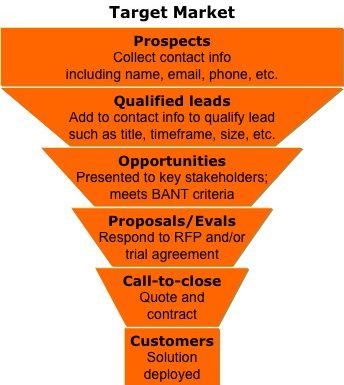 If the sales funnel is how you align sales and marketing, then defining the stages of the sales funnel is critical to strengthening that bond. While some (it should be all) organizations have embraced the concept of the sales funnel, the stages selected and what puts a lead in a certain stage varies widely.
If the sales funnel is how you align sales and marketing, then defining the stages of the sales funnel is critical to strengthening that bond. While some (it should be all) organizations have embraced the concept of the sales funnel, the stages selected and what puts a lead in a certain stage varies widely.
In an ideal world, there would be a common definition that all marketing and sales organizations could just implement much like developers implement standard protocols. But we know this is not an ideal world. In fact, many of us know that these standards take forever to define and have many options within them so you can only imagine how long it would take to get the sales funnel defined in a standards body since in many cases marketing and sales in ONE organization can’t agree.
This last point is what absolutely needs to be fixed if the sales and marketing organizations are to be aligned, and for that matter for the company to be successful. Sales and marketing must agree on what defines each stage of the sales funnel and use the same terminology across the entire funnel.
This is definitely a tall order and if you’re in the midst of defining these stages I feel for you. However, I can’t stress enough how critical it is for each stage to be clearly defined by outlining the criteria that must be met. If this doesn’t happen at the outset, and I’ve seen it many times, marketing and sales will become increasingly frustrated and always point the finger at each other when they are not successful.
I really wish I could post a clear definition for all the stages of the funnel but the reality is that it varies for each industry and organization. It is generally accepted that prospects are the first stage of the funnel although some dismiss this stage, since these leads are not qualified, but within them are your future potential customers. For this stage, it is crucial to define what types of info need to be collected in order to identify the qualified ones.
The definition of qualified leads varies widely and who handles them or when they are passed over forms one of the main tension points between marketing and sales. To define a qualified lead, I propose that marketing listen carefully to sales and ask them to outline what they see as an ideal account. Then take as many of these attributes as possible, collect that info and use that criteria as the basis for that stage in the funnel.
Another set of key criteria involves BANT (budget, authority, need, timeframe) and while it’s not always easy to collect, it definitely needs to be a key part of the sales opportunity stage, which is when sales take over the prospect. At this point, the info collected to date is validated and a judgment is made on whether there is the potential for this lead to become a customer.
The next couple of stages really depend on the target audience, the technical nature of the product and the sales process involved in closing deals. Quite often these stages are called proposal, evaluation and/or call-to-close stages but may go by many other names. What they are called is not important but there must be agreement on the name and what criteria needs to be met for leads to be in them. These stages involve both technical closure and business negotiation and could include RFPs, business cases or trials.
The final stage, where there is universal agreement, is the customer stage, which is where we want all our leads to end up. However, it’s important to not dismiss this stage as the end. It’s important to understand what percentage of prospects become customers, the value of them to the company and how they can be leverages to build the business which includes both as a proof point for other customers and to sell other solutions or use cases to them.
Since I strongly believe the sales funnel is crucial to the success of any company there will be several additional posts on this topic in the coming weeks so send me your questions and thoughts in the comments below. For now, it’s important to understand that the concepts mentioned here are a framework that needs to be adapted to fit your organization by sales and marketing working together.


extra resources
How to Align Sales and Marketing Part 2: Defining the Sales Funnel